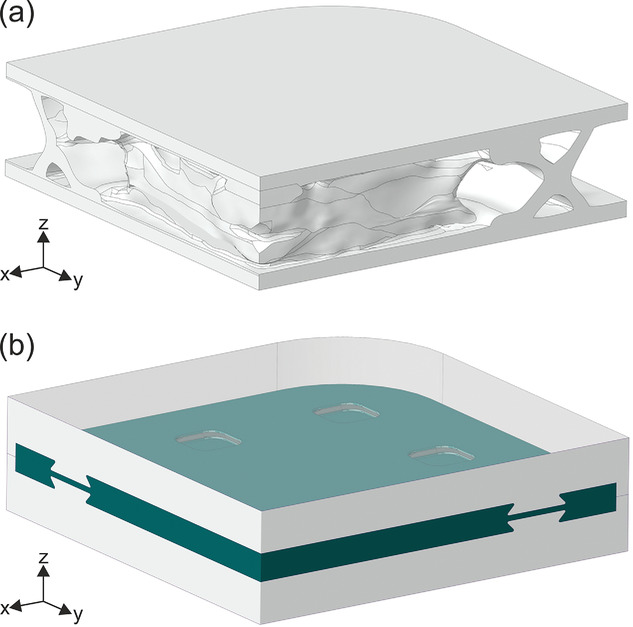In the recently published, ‘Impact Optimization of 3D Printed Poly(methyl methacrylate) for Cranial Implants,’ Sandra Petersmann, Martin Spoerk, Philipp Huber, Margit Lang, Gerald Pinter, and Florian Arbeite explore FFF 3D printing for medical implants, with a focus on impact behavior and examining the effects of infill density and pattern on 3D‐printed poly(methyl methacrylate) (PMMA).

Schematic representation of one 3D‐printed impact specimen with the investigated sandwich structure and its dimensions in mm a) and of the three investigated infill patterns of the sandwich core along with the respective infill densities b). In (a), the blue surface depicts the build platform during printing and the green arrow the impact direction during testing. The specimens are oriented in a way that the consecutive layers of printing are in z‐direction.
While 3D printing is helping researchers make huge strides in the medical field, there are still many challenges to be found in the fabrication of implants. One of the greatest—and understandable—challenges is that implants must be similar to the natural human structure and pulling that off is no easy feat. For cranial implants, the following characteristics are required:
- Inertness
- Biocompatibility
- Sterilizability
- Long-time stability
- Strength
- Durability
- Intraoperative workability
Researchers have focused heavily on polymers for 3D printing implants, and especially PEEK and PMMA.
“Both thermoplastics are inert, biocompatible, and reveal adequate mechanical properties in order to replace bone. PEEK outpaces PMMA in terms of strength, stiffness, and durability. In contrast, PMMA is easily obtainable and affordable,” stated the researchers.
Sandwich structures are popular, with layers varied in terms of orientation and structure, and mechanical properties improved with a structured core ‘to two stiff and thin outer layers.’ In using classic structures though, the researchers reported:
“All tests, regardless of infill density and structure, show a step‐wise failure behavior, which can be seen as several peaks in the force–displacement curves. This is a quite common phenomenon in sandwich structures, since the fracture behavior of the surface layers and the core material is quite different.”
The research team was able to improve stiffness and energy absorption, with the PMMA samples designed with a 50 percent reduction in weight. Internal structure was 3D printed with an infill density of 100 percent.

Quarter section of the PMMA impact specimens optimized by a topology a) and material b) optimization technique. The grey material refers to PMMA, whereas the green interlayer represents the soft TPC. The specimens are oriented in a way that the consecutive layers of printing are in z‐direction.
“Compared to other 50% infill density settings, the topology‐optimized structure performs quite well in terms of dynamic stiffness and FD. Both values are similar to 3D‐HC and higher than rectilinear and gyroid internal structures. However, in terms of overall fracture behavior it is close in shape to 70% 3D‐HC and 100% rectilinear structures, since it fails rather brittle without a pronounced stepwise crack propagation phase,” stated the researchers.
“Concluding the results, it appears that ED in combination with the dynamic stiffness or deformation reached up to this point represent a very critical parameter regarding the designing process of implants. If a high tolerated force level in relation to the absorbed energy is desired, 3D‐HC internal structures at an infill density of 70% and rectilinear structures with an infill density of 100% are recommended at this time.”

Comparison of the occurring failure mechanisms after impact testing 3D‐printed PMMA specimens including a–d) rectilinear, e–g) gyroid, and h–j) 3D honeycomb (3D‐HC) core structures with infill densities of 30%, 50%, 70%, and 100%. The side of the specimen toward the impactor is represented.
3D printing for cranial implants is an ongoing topic of study, as researchers experiment with making them out of titanium, explore the effects of regulation, and further innovations for patient-specific care.
What do you think of this news? Let us know your thoughts! Join the discussion of this and other 3D printing topics at 3DPrintBoard.com.
[Source / Images: ‘Impact Optimization of 3D Printed Poly(methyl methacrylate) for Cranial Implants]
Subscribe to Our Email Newsletter
Stay up-to-date on all the latest news from the 3D printing industry and receive information and offers from third party vendors.
You May Also Like
Nikon’s AM Expansion from California to Japan and Beyond: CEO Hamid Zarringhalam Weighs in
As we recently argued in a 3DPrint.com PRO article, Nikon Advanced Manufacturing has quickly gone from a prominent player in the metal additive manufacturing (AM) sector to become one of,...
The State of the Talent and Job Market in AM: 2025 Outlook
The additive manufacturing industry has seen significant shifts in recent years, with 2024 marking a critical turning point. Economic pressures, evolving hiring trends, and an increasing talent shortage at the...
SWISSto12 to 3D Print Antennas for SES’s Medium Earth Orbit Satellite Constellation
SWISSto12 has made a remarkable journey in satellite manufacturing. The company now produces its own HummingSat, as well as 3D-printed filters, waveguides, and other RF components. Recently, it was selected...
3DPOD 243: Volumetric 3D Printing with Xolo CCO, Stephan Kuehr
Stephan Kuehr began his career at 3YOURMIND before joining the volumetric 3D printing firm Xolo. In this episode of the 3DPOD, we discuss Xolo, its technology, volumetric 3D printing, bioprinting,...






























